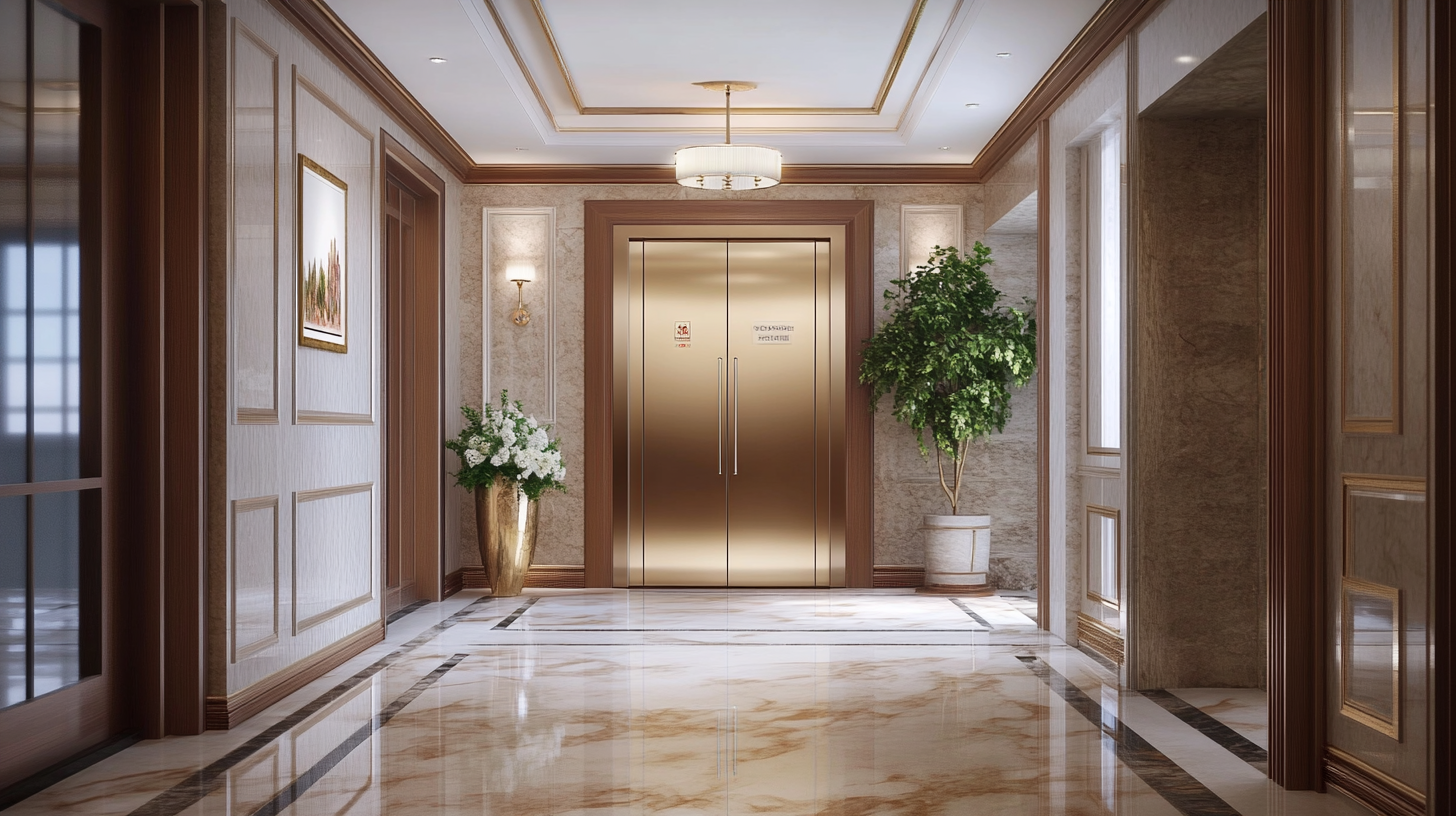Over the years, the need for automatic sliding doors is significantly increases for better accessibility in commercial places as well as energy efficiency improvements. As yardstick of such changing time, ADMA also stated that during the next five years, the market for automatic doors is likely to grow by an approximate CAGR of 5.2 percent. This trend has shown that advanced technologies were integrated into door systems. Organizations also seem to realize that these doors not only offer ways to enter and exit, but they also play a part in conserving energy used in air exchange between indoor and outdoor settings.
Modern innovations in the industry have been going to the next level to streamline the efficiency of these Automatic Doors. Among the latest developments, a smart sensor is one of the best examples of what is put into applied and automated control systems for energy-efficient materials that can act accordingly to human behavior interaction and real-time environmental changes. According to one study that was recently published in the International Journal of Building Pathology and Adaptation, most modern installed automatic door systems tend to use less output energy compared with traditional manual door systems by as much as 30%. The blog is intended to share some of the reinventive practices and technological innovations that have impacted Automatic Sliding Doors in different industries on their functionality and sustainability.

The modern era of automatic sliding doors is being finely tuned in terms of efficiency and functionality through the incorporation of smart sensors. Such advanced sensors make doors work easily in quickly adjusting to an approaching individual, and thus, reduced waiting times can give an enhanced experience for the user. Unlike earlier systems that were solely based on motion detection, these smart sensors work with infrared, radar, and advanced algorithms in order to ascertain exactly when a door should open for proper access, even amid heavy footfall or traffic. Smart sensors also facilitate a great deal of energy conservation. The doors are activated only in the actual sense, and therefore these systems minimize every unnecessary opening, which in turn decreases the energy loss due to heating or cooling. And, in many cases, a smart sensor system can also be programmed for that specific environment and can vary its sensitivity in accordance with foot-traffic patterns and the time of day. This adaptability not only works wonders in terms of energy efficiency but also adds to the longevity of the mechanical components of the doors, as they endure less wear and tear from reduced cycles of operation. The safety and security of the entry have also been enhanced by the implementation of smart sensors. With object detection and safety stop mechanisms, this prevents accidents occurring with unexpected closure of doors. In a commercial environment, the integrated data analytics would facilitate analysis at peak times, allowing for better optimization of businesses. Once again, the merits of smart sensors reach way beyond convenience. Rather, they are the complete answer to modern efficiency, safety, and sustainable requirements in the functioning of automatic sliding doors.

AI and ML integration in automatic sliding door systems is improving efficiency and functionality at an unprecedented level. The current report on MarketsandMarkets indicates that the smart door lock market, globally encompassing an area of USD 3.6 billion in 2020, is projected to reach USD 9.4 billion by 2025. This highlights an imminent takeover toward the automation and smart technology of physical access points. Therefore, with a demand build-up, good factors for manufacturers are available to enhance their products with AI-based solutions.
Using machine learning algorithms, an automatic sliding door can optimize its performance based on real-time data. For example, AI-manned sensors can observe foot traffic trends and modulate the speed of the door and its response time. A paper presented in the Journal of Building Performance states intelligent systems can help down energy consumption by 30 percent, enhancing sustainability while providing greater user comfort. This eventually aids in energy conservation while overall tending to the user experience.
A recent case example from Observe.AI demonstrates this resurgence of operational efficiency powered by AI. With AI-enabled analytics, companies could understand doors bottlenecks and mitigate them, increasing operational speed by up to 25 percent. The potential for such optimization reflects the show that blending advanced technologies with day-to-day systems leads to service delivery and efficiency in leaps and bounds, proving future potential for AI in automatic sliding doors.

They are important components for all modern commercial and residential buildings where easy access to a space is provided and most efficiently utilized. Still, concern regarding energy consumption looms larger. According to the Department of Energy, commercial buildings consume about 40% of all the energy consumed in the United States, and the doors play an important role in thermal performance. Innovative energy efficiency techniques can be applied to improving functions for such kinds of doors.
One of the proposed strategies for motion control in automatic sliding door systems is using advanced sensors and controls. Updating to high quality motion detectors can potentially decrease energy usage of an entire building by 30%, states a report from the International Energy Agency, enabling the door to operate at optimal capacity according to actual occupancies. Real-time adjustments also avoid unnecessary openings and heat and/or cool losses, which is especially beneficial in climates with extreme temperature fluctuation.
Another technique is the use of energy-efficient materials. For example, the National Institute of Standards and Technology indicates that using insulated glass in sliding doors would increase their thermal resistance and thus reduce heat transfer. Adding low-emissivity (low-E) coatings could further promote energy performance through reflecting internal heat back into the building during the winter months, improving indoor comfort levels and reducing energy needs for heating and cooling.
Finally, regular maintenance of automatic sliding doors can have a huge impact on energy consumption. A properly maintained door operates smoothly, making it certain that it closes tightly to the reduced availability of air leaks. The Building Green report states that routine inspections and timely repairs can lead to energy savings of as much as 15 percent. These new ideas for automatic sliding doors would be economically beneficial and, at the same time, contribute to the resource conservation efforts of the entire sector in buildings.

In this fast-paced environment, the significance of user-centric design in automatic sliding doors could not be overstated. According to research from the International Journal of Industrial Ergonomics, poor-directory entrances have been reported to annoy 70% of users which brings into focus the need for designing doors that are contingent on access and usability. That using user-centered principles would not only create an efficient convenience for people with disabilities but also improve it for the rest of us human beings, thus making the whole thing much more inclusive.
It also appears that touch-free activation and adjustable opening speeds are increasingly being regarded as both highly important and increasingly effective in increasing door utility. The addition or application of these makes doors capable of cutting wait time by as much as 30%, according to ANSI, which translates into an increased flow of foot traffic in those commercial areas. Clearly, this makes it necessary for designers and manufacturers to seriously consider how such elements could benefit the wider demographic, including the elderly and persons with mobility challenges.
Another great possibility of changing the current method of working automatic sliding doors would be the integration of smart technology in user-centric design approaches. When you develop sensors for use with automatic sliding doors, they can take on a new meaning-the sensors that learn from a user's behavior so as to open the door at just the right moment as that individual approaches. Recently, a report from the U.S. Department of Energy stated that energy-efficient automatic doors with such technology could reduce energy loss by 50% thus benefiting both the user experience and the environment. Accessibility becomes not only a plus for usability in modern facilities but also an important energy saver.
Automatic sliding door technology is fundamentally evolving, and the European market is a good testament to that. This is being driven by the increasing demand for energy-efficient solutions that are also user-friendly, thus making sliding doors the fastest-selling segments, netting revenues of about $2.8 billion as of 2023. With a compound annual growth rate (CAGR) of 5.6%, the segment is still expected to grow through the forecast period from 2024 to 2032. This makes it very important in innovation and development in efficiency as well as functionality of such systems.
Under the recent innovations, the introduction of smart technologies to automatic sliding doors is one of those integrating factors to this market. These devices are incorporated with sensors and networking via IoT connectivity, making effective automation and interactiveness for users. Newly constructed and designed sliding platform doors developed for railway stations provide safety as well as convenience while improving the passenger flow and energy management. With advancing technology, we would expect to see even more sophisticated designs that put more prominence on efficiency while still meeting the styles.
Besides this, sustainability seems to be a key impetus of innovations in automatic sliding doors. Most manufacturers have committed to deploying non-fossil, eco-friendly materials and energy-efficient mechanisms in order to minimize environmental effects. The principle of commitment aligns with global environmental objectives, as well as positioning automatic sliding door systems as a preferred option of the future in commercial and residential markets. The trend continues to promise that the phenomenon would continuously develop automatic sliding door technology even better in the future for easier access, safer application, and better efficiency.
Smart sensors enhance efficiency by responding quickly to individuals, reducing wait times, and minimizing energy loss by ensuring doors only open when needed. They also improve safety with features like object detection, and provide insights into peak usage times for businesses.
Smart sensors reduce unnecessary door openings by activating only when there is actual foot traffic, which minimizes energy loss associated with heating or cooling and prolongs the lifespan of the door mechanisms.
Smart sensors leverage a combination of infrared, radar, and advanced algorithms to accurately determine when to open, providing seamless access even in high-traffic areas.
AI and machine learning allow automatic sliding doors to optimize their performance by analyzing real-time data, such as foot traffic patterns, to adjust speed and response times, effectively reducing energy consumption.
The global smart door lock market is projected to grow from USD 3.6 billion in 2020 to USD 9.4 billion by 2025, highlighting a strong trend towards automation in physical access points.
Key trends include the integration of smart technologies and IoT connectivity, a focus on sustainability, and innovative designs that enhance efficiency and user interaction while addressing modern architectural needs.
They feature safety mechanisms, such as object detection and safety stops, that help prevent accidents caused by unexpected door closures.
Sliding doors are expected to generate approximately $2.8 billion in revenue in 2023, with a continued growth forecast in the coming years.
By integrating data analytics, businesses can gain insights into peak usage times, which allows them to optimize operations and improve service delivery.
Manufacturers are using eco-friendly materials and energy-efficient mechanisms to reduce environmental impact, aligning with global sustainability goals.